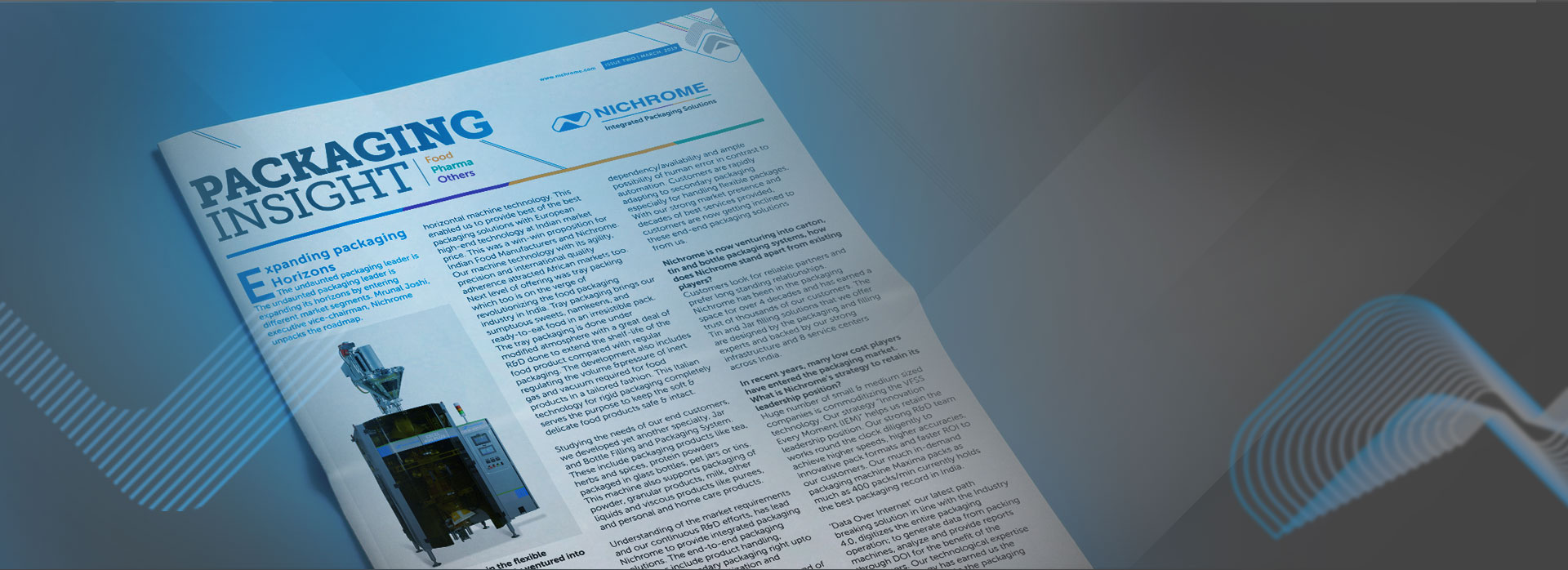Flexible Packaging in Modern India
Article by Milind Bhole, CEO, Neil & Sid Consultants, Pune.
Over the past 8 to 10 years, India has achieved tremendous growth in terms of industrialization and globalization. The inherent result of which, there has been tremendous demand of modern technologies and upgradation of quality of packaging and in general, the quality of life. India has achieved huge rise in food production brought about by the Green revolution. Food industry offers what is unquestionable, one of the largest opportunities for growth in India today. The industry will play a vital and positive role in the Indian economy. To reach such phenomenonal growth, it is quite evident that the processing and preservation technology of food products has to keep pace with the growth. Hence, it is expected that the modern technology of flexible packaging like Aseptic Packaging, Barrier Packaging, Controlled Atmospheric Packaging will make big inroads in India.
Before we look into the present scenario of market, I would like to focus on the growth of packaging business and also would like to spend a few minutes to explain what is my personal view of the definition of packaging and the philosophy I believe we should adopt in order to successfully establish packaging technology in India.
From ancient times, the practice of, which is today called 'PACKAGING', has been a vital technology of mankind. It is unquestionable that packaging has greatly contributed to culture and to society and that it continues to do so today in the age when the distribution of product has become an extremely important subject. Packaging can be said even to be "A face, which expresses the culture of a particular country". By this statement what I mean is that the packaging invented by a certain people illustrates the special characteristics of that culture. It is therefore, necessary for those engaged in packaging, package development and distribution, especially for food packaging, to make themselves aware of people's thought regarding life as well as that people's behavior patterns and to have deep understanding of the culture on which the behavior is based. Food packaging is directly connected with the dietary habits of each culture and dietary habits are a key part of each culture. Understanding these habits is crucial for success in food packaging business.

During pre-historic era, people hunted for food and soon they realized that they could keep their food longer if they protected it. Therefore, they made pockets out of large leaves and animal skin and kept water in containers made out of coconut shells and dried skins of vegetables, and eventually in bags and jars made out of leather. Plastics began to be used in one way or the other since around 1946 when Earl Silas Tupper began to produce and sell Tupperware - an airtight plastic container to homes. Inventions of Plasticising PVC in 1926, PVDC in 1933, LDPE in1935, PET in 1941, HDPE and PP in 1951 were the events leading to rapid and wide spread of plastics packaging. Film Extrusion began in the late 1940s - 1950s and that opened up a huge opportunity for packaging sector by creating a whole new industry when packaging was largely done with paper, glass, metal and occasionally wood and leather. Gradually, plastic packaging came into existence and began to increase market share to take care of consumer goods, medicine and food. F&J Heinz brought packaging into Ketchup in 1876, Heinz introduced 57 food products in the market and packaging took off. Today, virtually everything we use needs packaging.
Potential
The growth in the flexible packaging industry in India is mainly driven by the food and the pharmaceutical packaging sectors. The large and growing Indian middle class, along with the growth in organised retailing in the country are fuelling growth in the flexible packaging industry. Another factor, which has provided substantial stimulus to the packaging industry is the rapid growth of exports, which requires superior packaging standards for the international market. The Indian packaging industry is dominated by plastic flexible packaging. The traditional rigid packaging users have also been seen to shift to flexible packaging in recent times. According to industry sources, the main reason for this is that flexible packages are found aesthetically attractive, cost-effective and sturdy. Consumer preference for the use of convenient packaging and packaged products in affordable quantities in laminates is also one of the main reasons that have contributed to the growth of flexible packaging in India. The food-processing sector is the largest user of flexible packaging, accounting for more than 50% of the total demand. The flexible packaging segment is estimated to be growing at over 35% annually.
The Indian packaging industry is currently $18.8 billion with a growth rate of above 12.36% per annum - more than twice the global average while our GDP growth was 6-8%. Not only is the industry growing rapidly but it is also creating lucrative jobs for those who find a career in it. The packaging industry is expected to grow at 18-20% and is expected to reach $43.7 billion by 2022. India's per capita consumption of packaging is only 4.3 kg per person per annum, as against Germany's 42 kg and China's 20 kg, which is very low compared to global standards.
The packaging industry was growing at 12% per annum in India as against the global growth rate of 5%. There are roughly 22,000 packaging companies in the country covering from raw material manufacturers to machinery suppliers to ancillary material and nearly 85% of them are MSMEs. Flexible packaging demand in 2017 is estimated at $5.6 billion (~ Rs. 35,000 Crore). This represents about 30% of the total packaging in the country. At an estimated growth rate for this segment in the region of about 18% (estimates vary from 12 to 24%) the turnover achieved in 2022 should be in the region of $ 11-12 billion.
Laminated products including form-fill-seal pouches, laminated tubes and Tetra packs are growing at around 30% p.a. This also represents a corresponding additional requirement of capacity in the manufacturing sector. This means that the production will need to increase nearly 100% from the current levels. Considering that there is a major capacity addition witnessed in 2017 and slated in 2018, over and above what is on the blue prints, at least 80% additional capacity will need to be generated. This is a huge challenge before the nation and a great opportunity for the players in the Flexible Packaging arena. This also opens possibilities for new entrants in the field provided they meet the changing scenario of customer needs and new challenges.
Initiatives are needed to convert the large unpacked commodities into processed, packed and well-presented commodities. India's imports at 20-25% with a value of $125 million of its total packaging machinery indicate further opportunities not only for Indian companies to increase their share in domestic market but also for international companies to explore new business opportunities in India. The food & beverage and pharmaceutical segments occupy the largest share in the packaging industry, accounting for 85% and 10%, respectively. The plastic packaging market is expanding rapidly registering a growth of 20-25% per annum and is valued at 6.8 million tonnes while the paper packaging industry stands at 7.6 million tonnes. The packaging industry is poised to grow rapidly led by the increasing use of innovative packaging equipment and the rising volumes in flexible packaging market. So it can easily be concluded that the future is bright for flexible packaging in India for this decade.
Food
- Snacks & Namkeen Packaging Machine
- Ready-to-Eat Food Packaging Machine
- Grains & Seeds Packaging Machine
- Milk & liquids Packaging Machine
- Powder Packaging Machine
- Spice Packaging Machine
- Coffee Packaging Machine
- Sugar Packaging Machine
- Oil Packaging Machine
- Salt Packaging Machine
- Tea Packaging Machine

